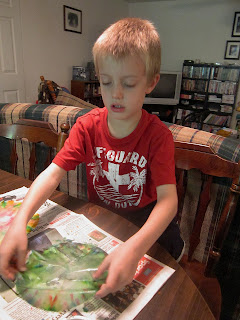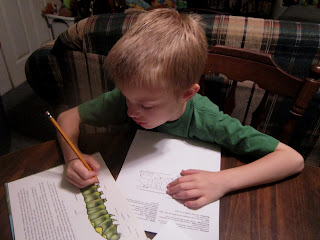Butterfly
vs. Moth
1.
Discuss:
Show the children a picture of a butterfly and a moth. Do
you see any differences
between the two? There are four major
differences between moths and butterflies.
- Butterflies are often more colorful than moths because butterflies are active during the day. Moths are active at night and have earthy colors to camouflage them while they sleep during the day.
- Most butterflies have club-shaped antennae or antennae with knobs on the end while a moth’s antennae are feather-like or taper to a point.
- Moths have a thicker coating of scales than butterflies, giving them a furry appearance. These heavy scales help keep them from losing heat during the night when they are most active.
- Butterflies grow a chrysalis and moths spin a cocoon.
Butterflies and moths have some similarities too. They are both insects which mean that they both have 3 body parts, six legs, and hatch from eggs.
2. Read: What's the Difference Between a Butterfly and a Moth by Robin Koontz
2. Read: What's the Difference Between a Butterfly and a Moth by Robin Koontz
3.
Comprehension
questions:
What
are the 4 differences between butterflies and moths?
- Butterflies are often more colorful than moths because butterflies are active during the day. Moths are active at night and have earthy colors to camouflage them while they sleep during the day.
- Most butterflies have club-shaped antennae or antennae with knobs on the end while a moth’s antennae are feather-like or taper to a point.
- Moths have a thicker coating of scales than butterflies, giving them a furry appearance.
- Butterflies grow a chrysalis and moths spin a cocoon.
What
are some similarities between butterflies and moths?
- Both are insects.
- Both have six legs.
- Both have 2 pair of wings.
- Both hatch from eggs.
Butterfly Suckers
I found these butterfly suckers in the Easter clearance at the store so I got them for a fun treat.
Butterfly
Adjectives
Discuss:
An
adjective is a describing word. Ask the children what words describe a
butterfly? Use adjectives to create an acrostic poem about
butterflies.
Create
an acrostic poem using the beginning letters of the word “butterfly”.
B
________________________________________________________________________________
U
________________________________________________________________________________
T
________________________________________________________________________________
T
________________________________________________________________________________
E
________________________________________________________________________________
R
________________________________________________________________________________
F
________________________________________________________________________________
L
________________________________________________________________________________
Y
________________________________________________________________________________
Butterfly
vs. Moth Venn Diagram
Materials:
- 2 hoola hoops
- note cards
- markers
Directions:
- Write one trait on each note card.
- Write "butterfly" one one note card and "moth" on one.
- Place the hoola hoops on the floor overlapping each other to form a Venn Diagram.
- Place the "butterfly" note card in one hoola hoop and the "moth" note card in the other.
Traits:
- six legs
- body is thick and looks hairy
- body is thin and doesn't look hairy
- compound eyes
- head, thorax, abdomen
- two pairs of wings
- makes a cocoon
- makes a chrysalis
- hatches from an egg
- two antennae
- mouth is a proboscis
- usually active at night
- usually active during the day
- is an insect
- usually brightly colored
- usually colored in earth-tones
- antennae are often thick and feathery
- antennae are club-shaped at the end
- undergoes complete metamorphosis
Identifying a Butterfly
We found a dead butterfly and tried to look at the traits with a magnifying glass and microscope. We decided that because of the bright colors and knobs on the antennae that it was a butterfly and not a moth.
Do You See the Difference?
We used pages 18 and 19 of Do You See the Difference to review some of the differences between butterflies and moths.
Locating
a Host Plant
Materials:
- 4 jams of the same color- These 4 can have different textures as long as they are all close to the same color. Some can even be the same flavor as long as the texture is different.
- 2 small paper plates
- 1 toothpick
- Lots of paper towels
Preparation:
1.
Set out two small paper plates and a tooth pick for every child.
2.
Assign a number to each of the four jams.
3.
Write the numbers for each of the four jams on one of the child’s
plates.
4.
Place a small amount of each jam next to its number on the plate.
5.
Write the name of one of the jams on the second plate and place a
small amount of that jam on it. This will be the host jam.
In
Class:
6.
Explain that once a butterfly has mated the female will carefully
search for the correct food plant for her eggs and caterpillars.
Butterflies are very picky about where they lay their eggs because
each species of butterfly caterpillar only eats specific
kinds of plants. These plants are called “host plants.” The
female butterfly instinctively recognizes the leaf shape, color,
odor, taste, texture, and appearance of her species’ host plant.
7.
Write the ways a butterfly recognizes a host plant on the board. color, odor, taste, texture, and apperance
8.
Tell the children that the labeled jam on their plate is their “host”
jam. Tell them to pretend that they are butterflies and that their
baby caterpillars will only be able to eat the right host jam. Students should
find their “host” jam on the second paper plate.
9.
Tell them to first observe their “host” jam and to list the
observations on their index card.
10.
Encourage students to use their senses to determine which mystery jam
is their “host” jam.
11.
When they think they have figured out which of the 4 mystery jams is
their “host” jam they should write down the number of that jam on
their index card.
12. When the children are done reveal what the host jam number is.
12. When the children are done reveal what the host jam number is.
13.
For each of the 4 “host” jams go around the room and ask what
senses the kids used to determine their host jam and what their
observations were about their jam.
14.
Explain that this is what a butterfly must go through when trying to
find its host plant.
Fun
Fact:
The criterion for selecting a mate is different from one species to
another. Some species of butterflies and moths will perform ritual
dances in the air or on leaves. A female may judge a male’s
strength and vigor by how well he follows her complicated
aerial
dance.
Butterfly Math Coloring
We finished off our study with a Butterfly Mach Coloring page to review some addition facts.













































